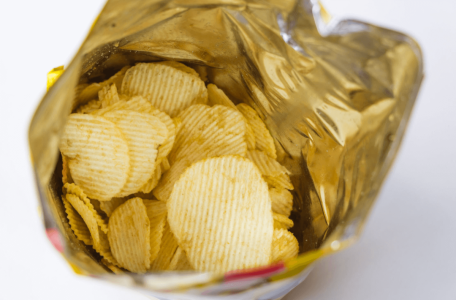The secret behind why your chip bags are only half-full
- Replies 7
Are you ready for the ultimate chip-packet conspiracy theory?
It's the mystery that has plagued chip lovers for generations: you buy a bag of your favourite brand, ready to sink your teeth into that satisfying crunch, but when you tear open the package, it's far from filled to the brim.
You can't help but wonder, 'What gives, chip companies? Are we really just paying for half a bag of chips?'
Well, brace yourself for a shocker, folks! The empty space in your chip bag is actually there for a very important reason, and it's called 'functional slack-fill.'
Yes, it's true. In the manufacturing industry, 'slack fill' is strategically placed around a product to protect it during its perilous journey from the factory to your favourite supermarket's shelves (or, you know, a vending machine).

Think about it, that journey can be rough and bumpy, and without the protective cushion of slack-fill, your chips would be nothing but crumbs by the time they reach their destination, otherwise known as your mouth.
So, the next time you open a bag of chips and feel a twinge of disappointment, just remember, it's all for the sake of chip preservation.
But wait, there's more! The secret to those big airy bags of chips you love is not just slack-fill, but also a dash of science. Chip manufacturers actually pump their bags full of nitrogen gas.
Nitrogen gas is like a 'superhero' for your chips, it displaces the oxygen in the pack, creating a shield that keeps your chips from going stale or becoming soggy.

But don't worry, before you start thinking that there's something dangerous in your bag of chips, rest assured that the small amount of nitrogen gas used to preserve your chips is completely harmless.
Nitrogen gas is an inert gas, which means it doesn't react with other elements, and it won't cause any harm to humans. (There was even a nitrogen-infused soda which was launched last year.)
In fact, it's a win-win situation, not only it extends the shelf life of your chips, but also makes them taste better. Fun fact: A study in 1994 found that chips exposed to nitrogen not only kept fresher for longer, but also retained some of their crunch!
So, the next time you open a bag of chips, give a little nod to the Nitrogen Gas, the unsung hero of the chip world.

Oxygen, the silent snack-killer, has long been on the most wanted list of food spoilage culprits, particularly for deliciously delicate treats like potato chips. The presence of oxygen in food packaging can lead to the formation of rancid fats, caused by the oxidation of the food.
It's not just the taste that's affected, but also the safety. Oxygen also encourages the growth of bacteria, mould, and other spoilage organisms, leading to food going bad faster.

In today's world, keeping oxygen away from our food is more important than ever. With food recalls becoming alarmingly frequent, manufacturers are constantly on the lookout for ways to reduce the risk of contamination.
By preventing the oxidation of food, food manufacturers can ensure that the chips you're munching on are not just crunchy and delicious, but also safe to eat.
Chip-lovers unite! Have you ever been curious by the empty space in your chip packets? Share your thoughts about this article in the comments below!
And while we're on the topic of chips, let's hear it - what are your go-to's in the supermarket? We're always on the lookout for new recommendations to add to our weekly snack-list, so send them our way!
It's the mystery that has plagued chip lovers for generations: you buy a bag of your favourite brand, ready to sink your teeth into that satisfying crunch, but when you tear open the package, it's far from filled to the brim.
You can't help but wonder, 'What gives, chip companies? Are we really just paying for half a bag of chips?'
Well, brace yourself for a shocker, folks! The empty space in your chip bag is actually there for a very important reason, and it's called 'functional slack-fill.'
Yes, it's true. In the manufacturing industry, 'slack fill' is strategically placed around a product to protect it during its perilous journey from the factory to your favourite supermarket's shelves (or, you know, a vending machine).

There's actually a good reason why manufacturers aren't filling your bag of chips to the brim. Credit: Pexels/Srattha Nualsate.
Think about it, that journey can be rough and bumpy, and without the protective cushion of slack-fill, your chips would be nothing but crumbs by the time they reach their destination, otherwise known as your mouth.
So, the next time you open a bag of chips and feel a twinge of disappointment, just remember, it's all for the sake of chip preservation.
But wait, there's more! The secret to those big airy bags of chips you love is not just slack-fill, but also a dash of science. Chip manufacturers actually pump their bags full of nitrogen gas.
Nitrogen gas is like a 'superhero' for your chips, it displaces the oxygen in the pack, creating a shield that keeps your chips from going stale or becoming soggy.

Slack fill is mostly made up of nitrogen, which helps keep the chips nice and crispy. Credit: Pexels/Veronica.
But don't worry, before you start thinking that there's something dangerous in your bag of chips, rest assured that the small amount of nitrogen gas used to preserve your chips is completely harmless.
Nitrogen gas is an inert gas, which means it doesn't react with other elements, and it won't cause any harm to humans. (There was even a nitrogen-infused soda which was launched last year.)
In fact, it's a win-win situation, not only it extends the shelf life of your chips, but also makes them taste better. Fun fact: A study in 1994 found that chips exposed to nitrogen not only kept fresher for longer, but also retained some of their crunch!
So, the next time you open a bag of chips, give a little nod to the Nitrogen Gas, the unsung hero of the chip world.
Key Takeaways
- The empty space in potato chip bags is known as 'functional slack-fill'.
- The extra room acts as a buffer to protect the chips from damage.
- The cushion in chip bags is made from nitrogen gas, which prevents chips from becoming stale or soggy.
- Nitrogen gas is not harmful to humans and helps to prevent the growth of bacteria and other microorganisms.
It's not just the taste that's affected, but also the safety. Oxygen also encourages the growth of bacteria, mould, and other spoilage organisms, leading to food going bad faster.

The less exposure to air the chips have, the less likely it is for them to spoil or go stale. Credit: Yan Krukau.
In today's world, keeping oxygen away from our food is more important than ever. With food recalls becoming alarmingly frequent, manufacturers are constantly on the lookout for ways to reduce the risk of contamination.
By preventing the oxidation of food, food manufacturers can ensure that the chips you're munching on are not just crunchy and delicious, but also safe to eat.
Chip-lovers unite! Have you ever been curious by the empty space in your chip packets? Share your thoughts about this article in the comments below!
And while we're on the topic of chips, let's hear it - what are your go-to's in the supermarket? We're always on the lookout for new recommendations to add to our weekly snack-list, so send them our way!







